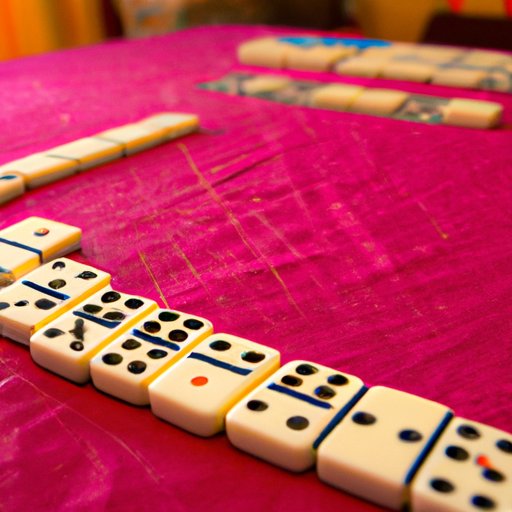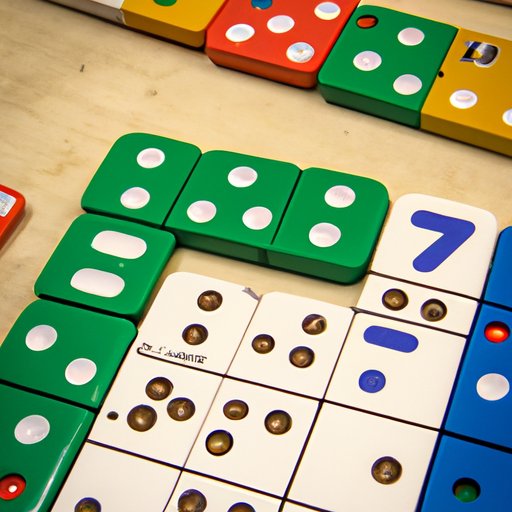
I. Introduction
Mexican Train is a popular game played with dominoes that has been enjoyed by people of all ages and backgrounds for many years. It is a game that is easy to learn but can take a lifetime to master, making it a great choice for casual players and competitive enthusiasts alike. If you are new to the game or simply want to improve your skills, this article will provide you with a comprehensive guide to playing Mexican Train, including step-by-step instructions, tips and tricks, and interesting trivia about the game’s history and evolution.
II. Step-by-step guide to playing Mexican Train for beginners
The objective of Mexican Train is to score the lowest number of points by playing all your dominoes before your opponents do. Here is a step-by-step guide to playing Mexican Train for beginners:
Setting up the game
1. Gather a set of double-twelve dominoes and shuffle them face down on the playing surface.
2. Each player draws a certain number of dominoes to start the game. For two to four players, each player draws 15, while for five to six players, each player draws 12. Unused dominoes are set aside in a boneyard.
3. The player with the highest double domino, called the engine or the locomotive, goes first. If no one has a double, players can draw a new domino until one is found.
Playing a turn
1. The first player places their engine in the center of the playing surface, creating the Mexican Train.
2. The player must then place a domino that matches the number of pips on one half of the engine.
3. If the player cannot play, they draw a domino from the boneyard. If it can be played, they must play it; otherwise, they pass the turn to the next player.
4. If a player has a double domino, they can play it sideways, creating two branching trains for other players to play on.
5. Players continue taking turns until one player runs out of dominoes or everyone is stuck.
6. If a player cannot play on their turn and the boneyard is empty, they must pass their turn.
Scoring points and ending the game
1. At the end of the game, players tally up the pips on their remaining dominoes.
2. The player with the lowest total score wins the game.
3. If a player wins by playing all their dominoes, they receive a bonus.
III. 5 tips to master Mexican Train like a pro
Now that you have a basic understanding of how to play Mexican Train, here are some tips that can help you improve your strategy and increase your chances of winning:
1. Plan ahead
Before you make your move, consider your options and try to anticipate your opponent’s moves. Think about how your placement will impact the trains and try to block your opponents from playing on them.
2. Block your opponents
Whenever possible, block your opponents by playing dominoes that they cannot play on. This will force them to draw from the boneyard, wasting their turn and giving you an advantage.
3. Manage your resources
It’s important to manage your resources and know when to hold back on playing certain dominoes. Don’t waste your high-scoring tiles too early and use them strategically to outscore your opponents.
4. Set up the end game
As the game progresses, set up your moves to ensure that you can play all your dominoes before your opponents. This will give you the lowest score and increase your chances of winning.
5. Play defensively
When you’re ahead and your opponents are struggling to catch up, play defensively by blocking their moves and making it harder for them to play on the Mexican Train. This will help you maintain your lead and secure your victory.

IV. The history behind Mexican Train and how to play it
Mexican Train originated in Mexico and is based on a similar game called Tren Cubano. It was introduced to the United States in the 1990s and quickly became popular among players of all ages and backgrounds. Unlike other domino games, Mexican Train can be played by any number of players, making it a great choice for family gatherings, parties, and other social events.
V. Mexican Train strategy: How to win the game every time
While there is no guaranteed way to win every game, there are some strategies you can use to improve your chances of winning and outscore your opponents:
1. Score points quickly
Try to score as many points as possible in the early rounds of the game. This will give you a head start and put pressure on your opponents to catch up.
2. Avoid getting blocked
Be cautious when playing your high-scoring tiles and avoid getting blocked by your opponents. Keep a close eye on the Mexican Train and block your opponents whenever possible.
3. Set up a winning move
Look for opportunities to set up a winning move by placing dominoes that will allow you to play all your tiles in one turn. This can be tricky, but with practice, you can become an expert at it.
4. Anticipate your opponents’ moves
Pay attention to your opponents’ moves and try to anticipate their next move. This will help you block them and secure your victory.
VI. Expert insights: Strategies and tactics to gain advantage in Mexican Train
Expert players often have unique tips and tricks that can help you gain an edge over your opponents. Here are some insights from experienced players to help you improve your game:
“Mexican Train is all about strategy,” says John, an experienced player. “The key is to watch your opponents and anticipate their moves. If you can block them and set up your moves in advance, you’re almost guaranteed to win.”
“Don’t be afraid to take risks,” advises Jeff, a seasoned player. “Sometimes, you have to play a high-scoring tile to stay in the game. But make sure you have a plan to get rid of it later on.”
“It’s important to be aware of the scoring system,” says Maria, a top player. “Don’t get too focused on blocking your opponents; sometimes, it’s better to play for points and stay ahead.”
VII. Mexican Train variations: Exploring exciting twists and rule changes
There are many variations of Mexican Train that can add excitement and challenge to the game. Here are some alternative rules you can try:
Using double-twelve dominoes
Instead of using double-six dominoes, use double-twelve dominoes to increase the challenge and complexity of the game.
Playing with a wild card
Add a wild card to the game that can be used to represent any number of pips, making it easier to play dominoes and score points.
Using different scoring systems
Try using a different scoring system, such as counting the number of tiles each player has left at the end of the game instead of counting pips.
VIII. Mexican Train for families: Foster bonding and teamwork through gameplay
Mexican Train is a great game for families, as it encourages communication, teamwork, and problem-solving skills. Here are some tips on how to adapt the game for younger players or family members who are less experienced with gaming:
Simplify the rules
If your family is new to the game, start with the basic rules and simplify the scoring system. As they become more comfortable with the game, you can gradually introduce more complex strategies and rules.
Pair up younger players with experienced players
Pair younger players with more experienced players to help them learn the game and improve their skills. This will also foster bonding and communication between family members.
Make it fun and competitive
Add a competitive element to the game by keeping score and setting up a family tournament. This will motivate players to improve their skills and have fun in the process.
IX. Conclusion
Mexican Train is a fun and engaging game that can be enjoyed by players of all ages and skill levels. By following these tips and strategies, you can improve your gameplay and increase your chances of winning. But more than that, Mexican Train is a great way to bond with family and friends and foster communication, teamwork, and problem-solving skills.




